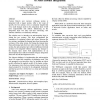Free Online Productivity Tools
i2Speak
i2Symbol
i2OCR
iTex2Img
iWeb2Print
iWeb2Shot
i2Type
iPdf2Split
iPdf2Merge
i2Bopomofo
i2Arabic
i2Style
i2Image
i2PDF
iLatex2Rtf
Sci2ools
OOPSLA
2007
Springer
2007
Springer
IAnticorruption: a domain-driven design approach to more robust integration
Custom House's new currency exchange system is integrated with a legacy system. After a few years of growth, the two systems were so intricately tangled that even small changes made in the integration layer would have unpredictable side effects. Refactoring on the integration layer was risky and time consuming. The situation called for a revolutionary redesign. The solution was to introduce an anticorruption layer to isolate the two systems. This layer encapsulated the translation of conceptual objects and actions between the two systems, insulating the domain layer from knowing the existence of the other system. By freeing the domain layer from performing tasks that were only relevant to the other system, the anticorruption layer allowed additional external systems to be integrated without requiring any changes to the domain layer itself. Full implementation of an anticorruption layer reduced overhead of legacy integration from 30% of total development to 10%. The biggest challe...
| Added | 08 Jun 2010 |
| Updated | 08 Jun 2010 |
| Type | Conference |
| Year | 2007 |
| Where | OOPSLA |
| Authors | Sam Peng, Ying Hu |
Comments (0)

